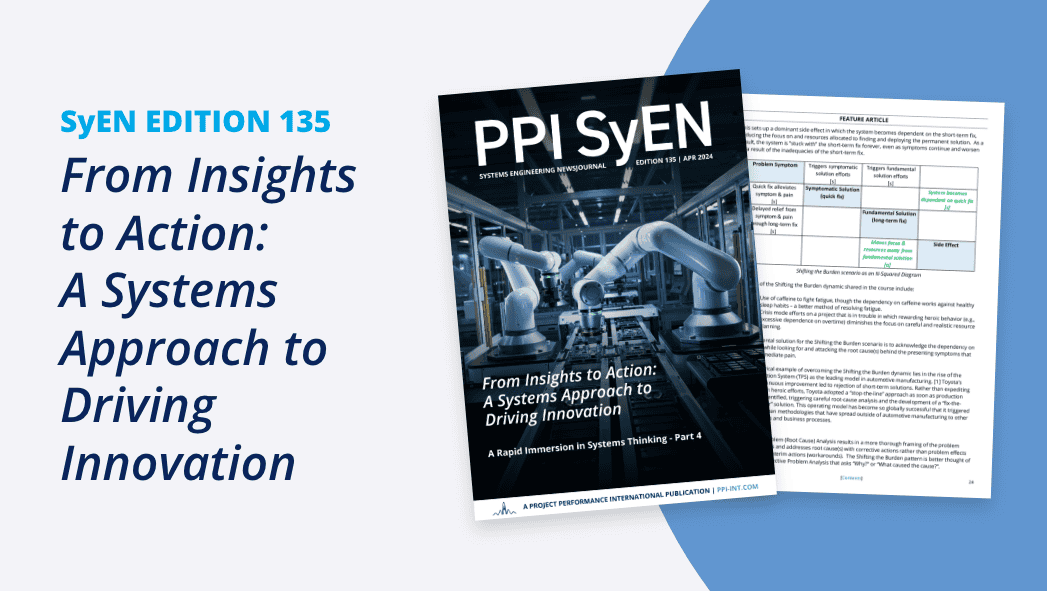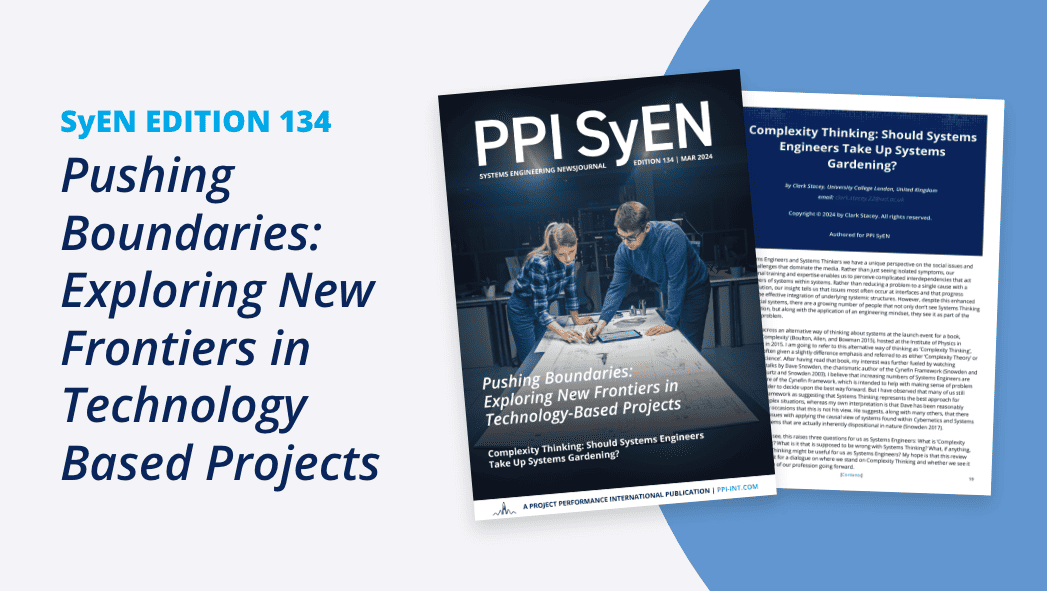IN THIS EDITION
1. Quotations to Open On
2. Feature Articles
2.1 Product Family and Product Platform Benchmarking for Redesign by Timothy W. Simpson
3. Notable Articles and Videos
3.1 INCOSE Releases 30th Anniversary Video
3.2 Updates to INCOSE Working Groups’ Activities
3.3 INCOSE Brasil Chapter YouTube Channel
3.4 YouTube Presentation by Professor Jose Fernandez – April 29, 2020
4. Systems Engineering News
4.2 SERC Research Review Scheduled for November 2020
4.3 Call for Papers: “Engineering Ethics: Bridging the Theory – Practice Gap” International Journal of Technoethics
4.4 Job Vacancy: Professor/Associate Professor in Systems Engineering for Cyber-Physical Systems
4.5 June 2020 Edition of the Digital Engineering Working Group Available
4.6 INCOSE Seeks Candidates for Deputy Technical Director
4.7 Submit Papers to the 4th Complex Systems Design & Management Asia Conference
5.1 System of Systems Engineering Collaborators Information Exchange (SoSECIE)
5.2 Centre for System Philosophy (CSP)
5.3 International Society for the System Sciences (ISSS)
5.4 New England (USA) Complex Systems Institute
5.5 Institute for Ethics and Emerging Technologies
6. News on Software Tools Supporting Systems Engineering
6.1 Phoenix Integration Awarded a NASA SBIR Phase II to Develop a Collaborative Framework for Model Based Engineering Sharing
6.2 Autodesk Announces Construction Cloud
6.3 Altran Launches Code Defect AI
7. Systems Engineering Publications
7.1 Thriving at the Edge of Chaos: Managing Projects as Complex Adaptive Systems
7.2 Risk Up Front: Managing Projects in a Complex World
7.3 What is Disruptive Innovation?
7.4 The Future of Systems Engineering
7.5 Systems Principles, Systems Science, and the Future of Systems Engineering
7.6 Systems Engineering Principles and Hypotheses
7.7 Practical Model-Based Systems Engineering
8. Education and Academia
8.1 Technical University of Madrid, Spain
8.2 Rensselaer Polytechnic Institute (USA)
9. Some Systems Engineering-Relevant Websites
10. Standards and Guides
10.1 Development of New Standards for Systems of Systems Engineering
10.2 IEEE 2413TM-2019, Standard for an Architectural Framework for the Internet of Things (IoT)
11. Some Definitions to Close On
11.1 Resilience
11.2 Pipelines of Processes in Object Oriented Architecture (PPOOA)
11.3 Complex Systems
11.4 Complex Adaptive Systems (CAS)
11.5 Complexity Science
12. Conferences and Meetings
International Conference on Human Interaction & Emerging Technologies, August 27th – 29nd, 2020
13. PPI and CTI News
13.1 Robert Halligan Presents at INCOSE IS: ‘Developing the PPI-INCOSE SETDB Using an SE Approach’
13.2 PPI Exhibits at the INCOSE IS, 20-22 July 2020
13.3 At last: Interface Engineering and Management Training for the World
13.4 PPI Turns 41
14. PPI and CTI Events
15. Upcoming PPI Participation in Professional Conferences
Editor’s Note
A special feature of this issue of PPI SyEN is that we report on the efforts of The INCOSE Systems Engineering Principles Action Team which has provided its view of the future of systems engineering and put forth a set of principles and hypotheses to articulate the basic concepts that guide systems engineering. The team based this work on a review of various sources of systems postulates, principles, and hypotheses identified in the literature. Please take special note of the related references to this work in the SE Publications section.
Also, INCOSE has updated its Webpages concerning the INCOSE Working Groups (WG). A special article is provided below that describes several new working groups, provides links to “Working Group Information Sheets” (WIS) that were developed at the 2020 INCOSE International Workshop, and includes a table that identifies the WG leads.
“Engineers love to solve problems; those practicing systems engineering love to solve the right problems.”
“Whoever you are or wherever you’re from, audacious goals can be accomplished with grit, purpose, and a growth mindset. All of us can do more than we think because we all have reservoirs of untapped potential to achieve our dreams.”
Jenna Besaw
“Start by doing what is necessary; then do what is possible; and suddenly you are doing the impossible.”
St. Francis of Assisi
2.1 Product Family and Product Platform Benchmarking for Redesign
by
Email: tws8@psu.edu
The Pennsylvania State University, University Park, PA USA
May, 2020
Abstract
As companies are pressured to reduce costs and lead-times while increasing variety for the global marketplace, the need to design products based on common platform “elements” is growing. Product family design has become an effective strategy to meet this challenge, but companies still struggle with assessing how “good” their product family is and redesigning platform “elements” to be effective in the marketplace. Companies routinely benchmark individual products, but they struggle with how to benchmark their product families and associated platform “elements” against competitive offerings. This article discusses an approach to guide product family benchmarking and platform redesign. The approach uses easy-to-compute metrics to assess (i) commonality and (ii) variety of the products in each family being benchmarked. These metrics are then plotted to compare the effectiveness of modules/components within each family and identify platform “elements” that may need to be redesigned to save money or improve market fit. An example involving two families of men’s razors is used to demonstrate the approach and discuss its implications on product platform redesign.
Copyright © 2020 by Timothy W. Simpson. All rights reserved.
Introduction
As many have heard, when Henry Ford first introduced the Model T, he offered, “…any color car so long as it’s black”, but these days, Ford, like most other automakers, offers hundreds of different models, thousands of different variants, and millions of combinations of colors, upholstery, trim, etc. In fact, companies that want to remain competitive in today’s global market must increasingly offer a variety of products to satisfy the diverse demands and needs of customers. Introducing new products and variants quickly and cost-effectively remains a constant challenge, and many companies have adopted platform-based product development approaches to stay competitive (Simpson, et al., 2006; 2014). Platform-based product development enables a company to establish a set of common components, modules, technologies, or “elements” that are then shared across a family of products (McGrath, 1995; Robertson and Ulrich, 1998). This sharing is intentional, not accidental, as individual variants are derived from these shared “elements”, more commonly referred to as a product platform, to reduce development costs and shorten manufacturing lead-times (Meyer and Lehnerd, 1997).
Despite the emphasis on product families and platform-based product development in many industries, customers buy individual products, not product families. Hence, comparing one’s individual product offerings against competing products has become standard practice in the majority of consumer products industries. Meanwhile, companies like Consumer Reports and J.D. Power have made successful businesses based on product benchmarking and consumer recommendations, and companies like Munro and Associates do nothing but teardown and “competitive benchmarking”, selling the data to firms to supplement their in-house data.
Benchmarking requires rigorous and systematic approaches for comparing products against one another, and there are well established methods for dissecting and reverse engineering individual products (Ingle, 1994; Otto and Wood, 2001; Yasin, 2002). However, having worked with a variety of companies over the past 20 years, it is clear that even though customers may not care about a product family or platforming, companies do, particularly as competition heats up around the global. Unfortunately, there are no approaches for benchmarking product platforms, platform “elements”, or families of products against one another in the literature. Based on countless interactions with companies, an approach to systematically compare competing families of products using easy-to-compute metrics has been developed to assess how well each platform “element” balances commonality and variety in the family (Simpson, 2017). The proposed approach is described in the next section with an example involving two competing families of men’s razors in the market.
Approach to Product Family Benchmarking and Platform Redesign
The approach for benchmarking product families and individual platform “elements” based on variety and commonality is shown in Figure 1. The approach begins by identifying the families of products that are being benchmarked. Two families of men’s razors from Gillette and Schick that are readily available in the market (see Figure 2) are benchmarked to demonstrate this approach. While this first step seems relatively straightforward, it is not trivial to find an entire product family in one place as companies never display their entirely line of products on a single store shelf. Different retailers often offer different models (i.e., variants) of each product in the family at different stores, and regional variations and special promotions (e.g., Olympics, World Cup) may also lead to new variants in the product family. The most useful insights come when products are from direct competitors in the same price/performance tier in the market; comparing high-end offerings from one company against the low-end offerings from another will likely not be helpful.
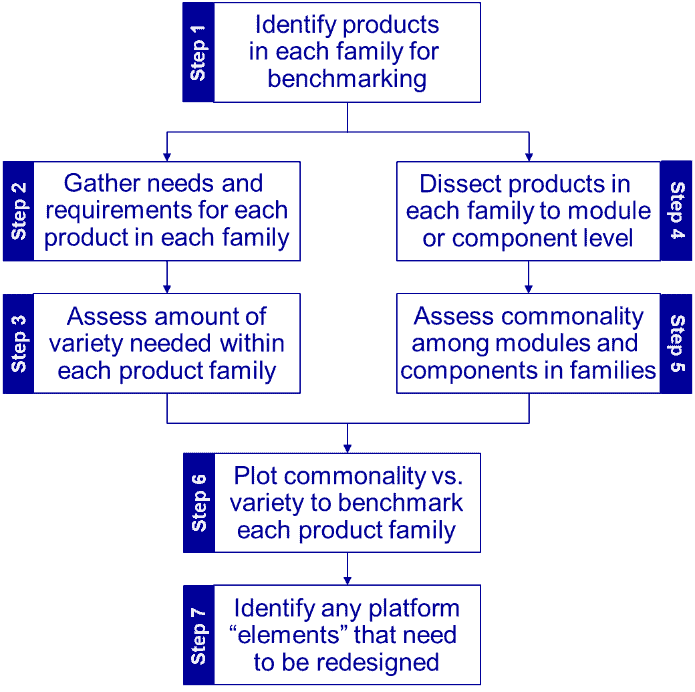 |
 |
| (a) Men’s razor family from Gillette | |
 |
|
| (b) Men’s razor family from Schick | |
| Figure 1: Approach for product family benchmarking | Figure 2: Product families for benchmarking |
Once the family of products is identified, Step 2 entails gathering the customer needs and associated requirements for each product in the family. This is where comparing products in the same price/performance is important as it helps ensure that both families are attempting to address the same set of customer needs and requirements. Again, the platforming strategy for a company competing in a high-end market segment will likely be different from one competing in a low-end segment. This also makes it easier to assess the amount of variety needed within each product family (Step 3) as both families will be targeting the same set of needs and requirements. The real differences that arise are thus more easily attributable to the platform architecture and common and unique “elements” used in each product family being benchmarked.
The amount of variety needed within each product family is assessed in Step 3 based on the range of needs and requirements identified in Step 2. This can be accomplished in a variety of ways; however, one of the easiest approaches is the Generational Variety Index (GVI) developed by Martin and Ishii (2002). GVI is computed using the House of Quality (HOQ), a tool from Quality Function Deployment (QFD) that is often used by many companies to map customer needs to engineering requirements and specifications for components and modules (Hauser and Clausing, 1998; Chan and Wu, 2002). GVI is computed by adding sub-levels to the “basement” of the HOQ so that multiple products are considered at once as opposed to a single product, which is often how QFD is commonly deployed. The range of customer needs for the family of products is then translated into a corresponding range of engineering requirements and ultimately a corresponding range of specifications for components and modules. GVI then assesses on a scale of 1-9 the extent to which each module or component will have to be redesigned to meet the range of customer needs, which drives the range of requirements that must be met. If the modules or components impacted by those requirements need to be redesigned, then they get a high GVI score for major redesign (9), partial redesign (6), numerous small changes (3), or few minor changes (1); otherwise, a score of zero is assigned if no changes are required. These scores are then tallied to yield an overall GVI score for each module and component analyzed in the family. Figure 3 shows an example of Steps 2 & 3 for the men’s razor family; at this level, the results are the same for both families of razors.
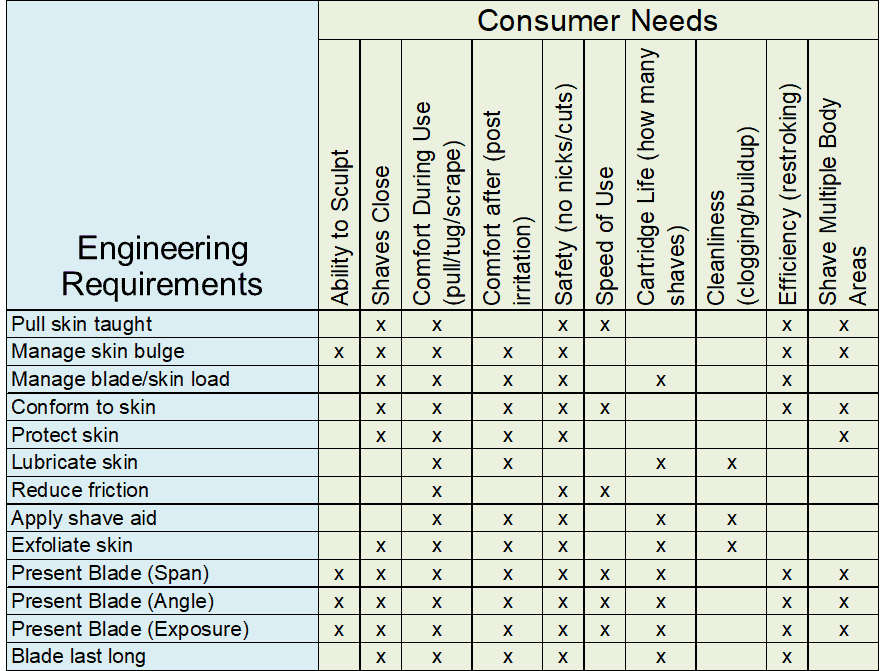
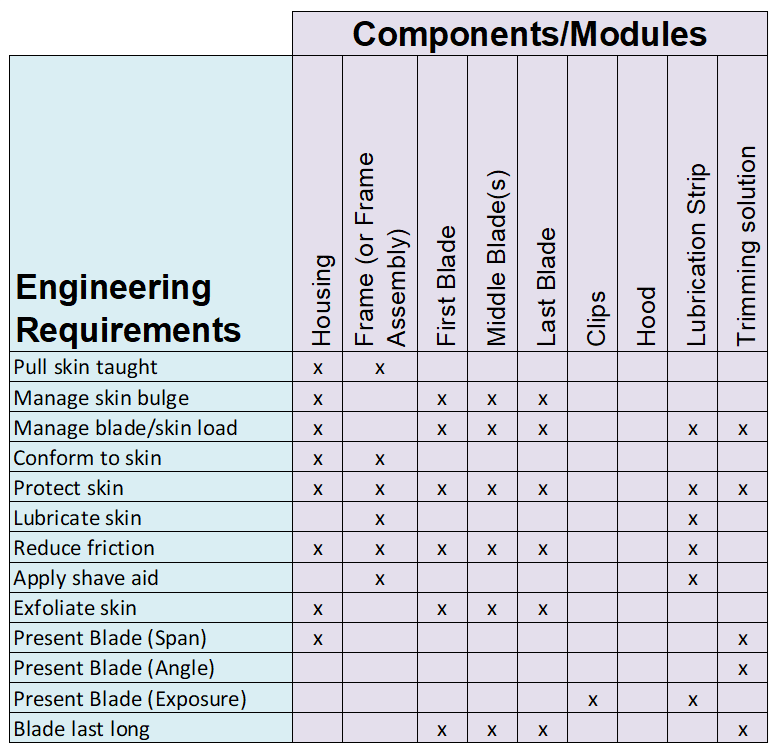
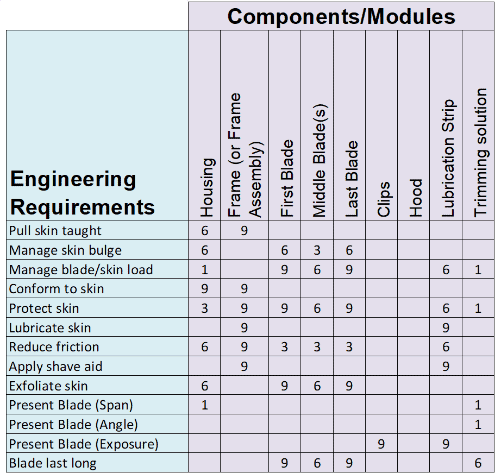
| (a) Customer needs are mapped to engineering requirements |
(b) Engineering requirements are mapped to modules/components | (c) Extent of redesign for each module or components is estimated |
Figure 3: Customer needs mapped to engineering requirements and modules/components to compute GVI
The commonality within each product family is analyzed in Steps 4 & 5 by dissecting each product in the family to the module/component level (see Figure 4) and computing a commonality index to assess the level of commonality among components and modules. While there are many commonality indices available (Thevenot and Simpson, 2006), the Product Line Commonality Index (PCI) proposed by Kota et al. (2000) works well for benchmarking because it scores commonality at the module/component level as well as for the entire product family. PCI is computed using Equation (1) and ranges from 0% when there is no commonality among the modules or components in the family being analyzed to 100% when every module/component in the family is common. Figure 5 provides an example of how PCI is computed after dissecting one of the men’s razor families.
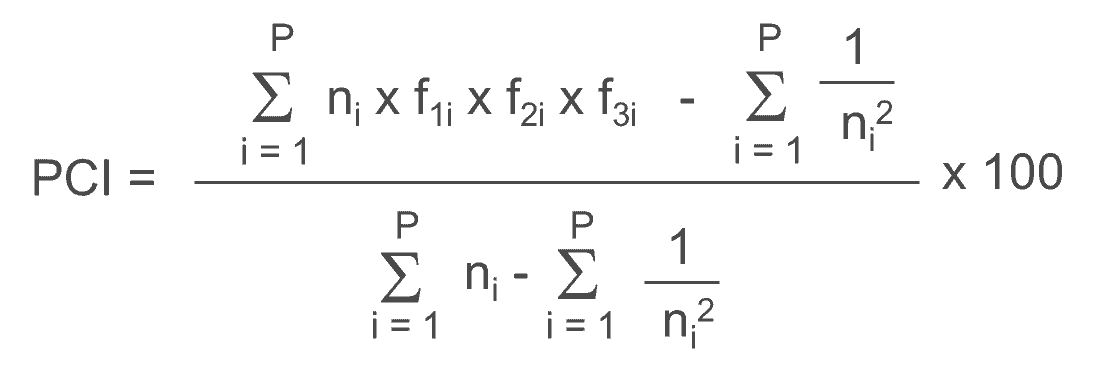 (1) (1) |
N = # of products in the product family
P = total # of non-unique modules/components ni = # of products that have module/component i f1i = size and shape factor for module/component i f2i = materials and manufacturing processes factor for module/component i f3i = assembly/fastening scheme factor for module/component i fji = k/n where k is the # of products that share component i; j = {1, 2, 3} |
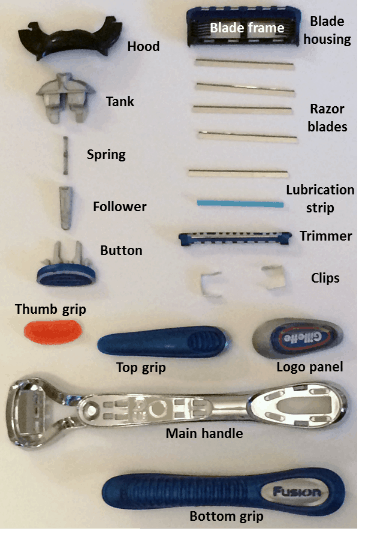 |
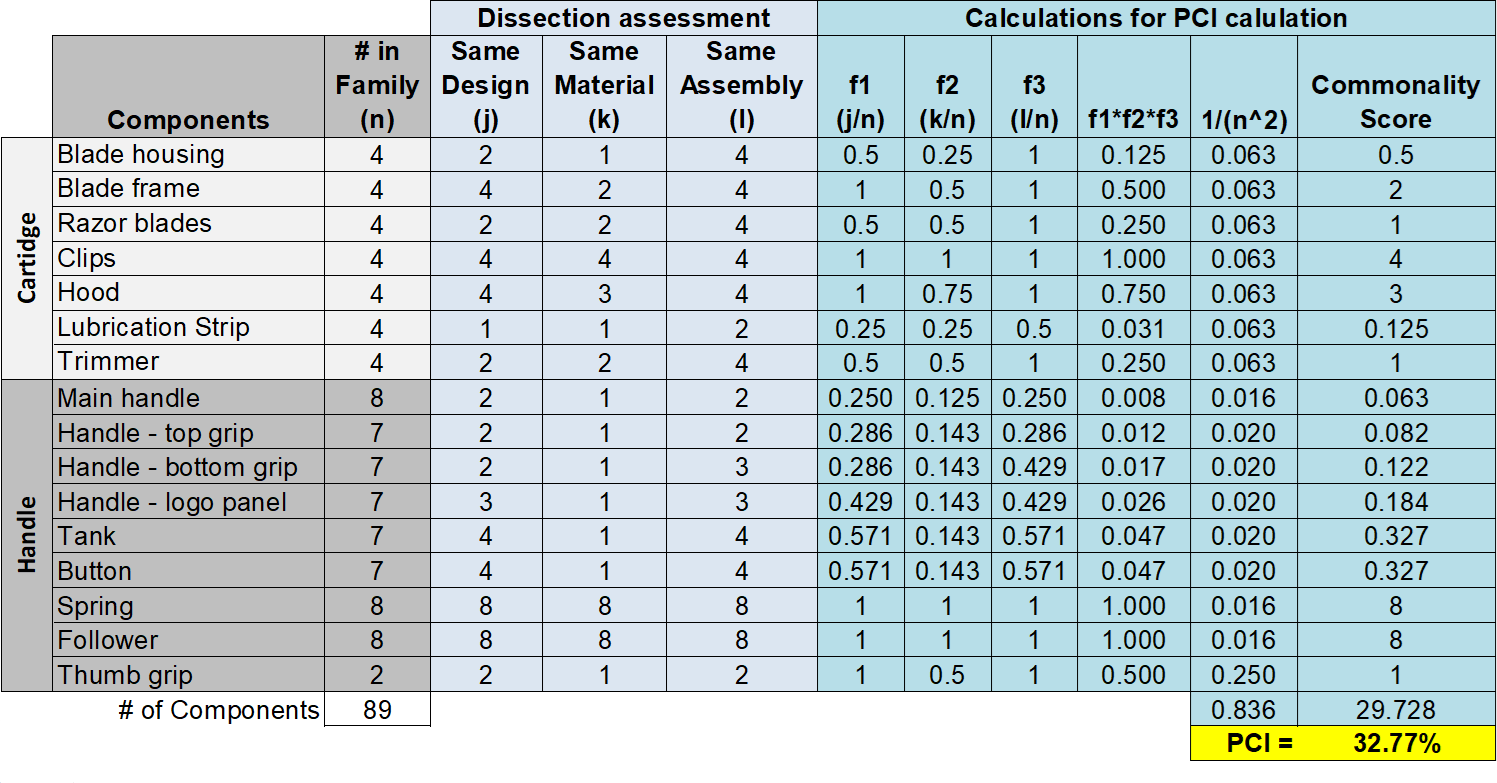 |
| Figure 4: Dissected men’s razor | Figure 5: Example PCI computation for men’s razor family |
The commonality score for each module/component is normalized and plotted against the normalized GVI value for the corresponding module/component in Step 6 to create a Commonality-Variety Tradeoff Chart that can be used to assess the platforming strategy within the family and identify modules and components for redesign. Figure 6a plots the results for the men’s razor family using the GVI data (in Figure 3) and PCI data (in Figure 5) normalized against the high and low values, respectively, in each family. Figure 6b highlights how the different regions in the tradeoff chart can be interpreted. Specifically, modules or components that are close to the diagonal are properly platformed:
- Modules/components with high PCI and low GVI scores offer competitive commonality because they have lots of commonality and the associated variety they need for the market is low, and
- Modules/components with low PCI and high GVI scores offer valued variety because they are unique (i.e., not common) because the associated variety they need for the market is high.
Meanwhile, modules and components that are far from the diagonal are either costly or confusing buyers:
- Modules/components with high PCI and high GVI scores are creating a market mismatch because the variety needs in the market are high yet they are common and lack differentiation, causing confusion, and
- Modules/components with low PCI and low GVI scores are providing unvalued uniqueness because the associated variety needs for the market are low yet they lack commonality, adding unnecessary costs.
The color-coding emphasizes this as modules/components falling in the “green zone” have good alignment while those in the “red zone” are either leaving money on the table (low PCI and low GVI scores) or detrimental to sales given the lack of differentiation (high PCI and high GVI scores) among these modules/components. As such, modules/components falling in the “red zone” should be targeted for redesign to improve commonality and save money or reduce commonality to differentiate products more and potentially increase sales.
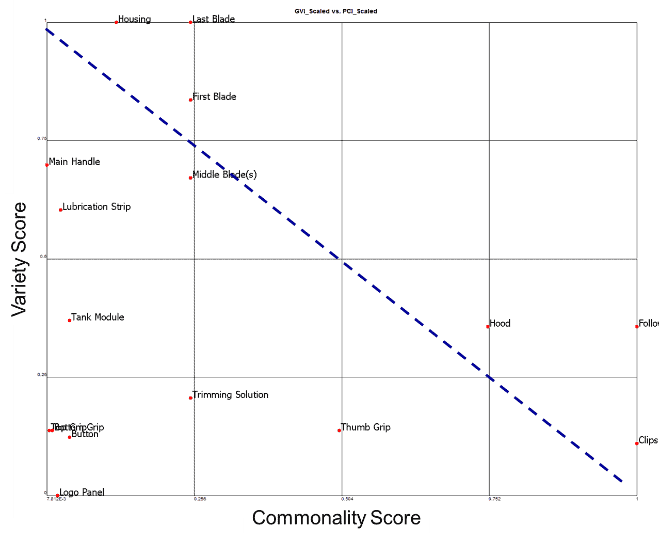 |
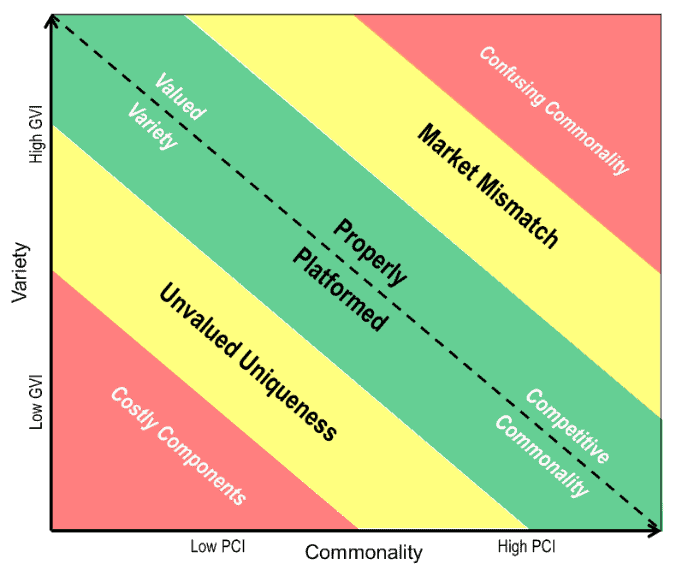 |
| (a) Commonality-Variety Tradeoff Chart for Gillette razors | (b) Zones of interest based on commonality and variety |
| Figure 6: Assessing tradeoff between commonality and variety within a product family | |
The Commonality-Variety Tradeoff Chart can also be used to benchmark competing product families and their associated platforming strategy as shown in Figure 7. By performing the same analysis on two (or more) product families within the same market segment (i.e., similar sets of needs and requirements), the normalized PCI and GVI scores can be plotted against one another. The location of the corresponding modules/components in each family provides insight each product family and its platforming strategy. As example is shown in Figure 7 for two families of men’s razors—the one from Gillette that we have been analyzing (see Figure 2a) along with a comparable set of men’s razors from Schick (see Figure 2b).
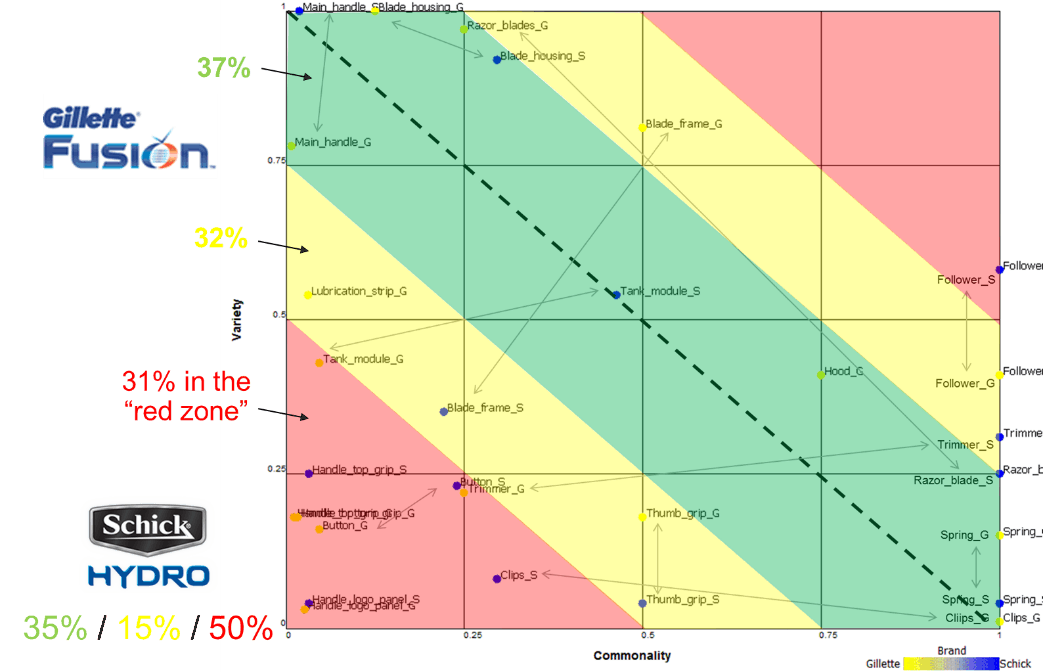 |
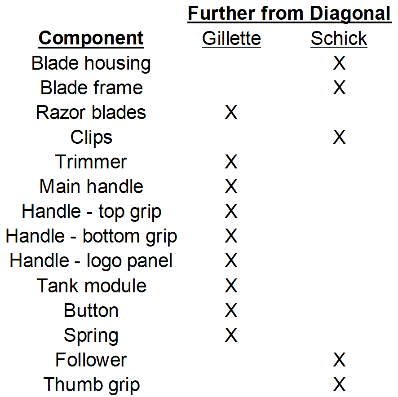
Figure 8: Benchmarking individual |
| Figure 7: Product family benchmarking using commonality and variety | modules/components in each family |
Once with the GVI and PCI scores are plotted in the same chart, there are a number of ways that each family can be benchmarked. For instance, the number of modules/components that each family has in each “zone” can be counted. In this example, the 37%, 32%, and 31% of the modules/components in the men’s razors from Gillette fall in the green, yellow, and red zones, respectively, while the distribution is 35%, 15%, and 50% for the modules/components in the men’s razors from Schick.
This indicates that while both families have properly platformed roughly the same number of modules/components, Schick has more components in the “red zone”, which in this case fall in the region of unvalued uniqueness. In short, the men’s razors from Schick could have had more commonality among these modules/components, which means that they have left money on the table because they differentiated modules/components that did not need to be distinct based on the range of needs and requirements considered in this analysis. Based on this analysis, Schick and Gillette now know where to start redesigning modules/components to reduce costs and improve its platform strategy.
Another way to use this chart is to pair each module/component from each family and see which one is closer to the diagonal. The closer to the diagonal a module/component, the better aligned the platform (and non-platform) “elements” are with the variety needed for the market. The arrows in Figure 7 indicated the paired modules/components across the two families of men’s razors, and Figure 8 summarizes the results for 14 of the modules/components that exist in both families. Interestingly, even though the men’s razors from Schick had more modules/components in the “red zone”, Gillette has more modules/components further from the diagonal compared to Schick: 9 out 14 (64%) for Gillette versus 5 out of 14 (36%) for Schick. Based on this analysis, Gillette and Schick can now identify which modules/components to prioritize based on that are farthest away from the diagonal. Furthermore, by starting with those in the “red zone”, Gillette can redesign modules/components to reduce cost by improving its platforming strategy; Schick can of course do the same.
Summary and Conclusions
Benchmarking is well established in many industries; however, as new competitors arise and variety increases in the global market, the pressure to offer cost-effective families of products based on shared platform “elements” is mounting. Toward this end, an approach for benchmarking a family of products is presented and demonstrated using two families of men’s razors that are readily available in the market. The approach leverages easy-to-use metrics for product family analysis and integrates them into a single chart that enables benchmarking of the modules/components in each family of products. Application to two families of men’s razors illustrates how the approach provides insights into the effectiveness of each company’s product platform strategy, namely, how well have the various modules/components in each family been platformed (i.e., made common) or not. This information can be used to identify and prioritize which modules/components to target for redesign to either improve commonality to save costs or reducing commonality to increase differentiation and improve market fit. Meanwhile, the Commonality-Variety Tradeoff Chart provides useful insight into which modules/components are properly platformed (i.e., competitive commonality or variety that is valued), causing confusion through market mismatch, or providing unvalued uniqueness that is leading to costly components.
Successful application of this approach to product family benchmarking and product platform redesign is based on many assumptions. First, it assumes that both families have similar architectures along with similar modules/components in each family (e.g., razor blade, handle, etc. in this example). Side-by-side comparisons would be difficult if each product family had a radically different architecture, although unique insights may be revealed from the locations of each family’s modules/components in the Commonality-Variety Tradeoff Chart. Interfaces between modules/components within each family also play an important role when it comes to offering variety, and they are not taken into consideration in the current approach. The depth of analysis also hinges upon the level of detail of the products being analyzed. For larger, or more complex products, the analysis may need to be performed at the subsystem/subassembly level versus at the component level that was possible in this example. The approach also assumes that the products being dissected and analyzed are primarily mechanical; the dissection and analysis portion of the approach would need to be modified if the product families consisted of extensive electronics and embedded systems or relied heavily on software to achieve functionality. Finally, normalization of the variety (GVI) and commonality (PCI) indices assumes that all modules/components are comparable in terms of their cost and value to the family. In reality, the costs (and value) associated with different modules/components varies substantially, and the GVI and PCI scores could be weighted prior to normalization. Likewise, prioritization of modules/components for redesign could be weighted based on the cost or time needed to modify each one to improve commonality (or distinctiveness) in the family.
List of Acronyms Used in this Paper
Acronym Explanation
GVI Generational Variety Index
HOQ House of Quality
QFD Quality Function Deployment
PCI Product line Commonality Index
Acknowledgements
The author is grateful to Greg A. for his assistance with the razor family analysis. With more than two decades in the razor industry, his insights and observations were invaluable for this benchmarking study.
Disclosure
All data was based on publicly available information, and the analysis was conducted on products readily available in the market. Any opinions, findings, and conclusions or recommendations expressed in this material are those of the author and do not necessarily reflect the views of either of the companies referenced in the case study.
References
Chan, L.-K. and Wu, M.-L. “Quality Function Deployment: A Literature Review,” European Journal of Operational Research, 143(3), 463-497, 2002.
Hauser, J. R. and Clausing, D. “The House of Quality,” Harvard Business Review, 66(3), 63-73, 1988.
Ingle, K. A. Reverse Engineering, McGraw-Hill, New York, NY, 1994, 240 pages. ISBN 978-0-0703-1693-5.
Kota, S., Sethuraman, K., and Miller, R. “A Metric for Evaluating Design Commonality in Product Families,” ASME Journal of Mechanical Design, 122(4), 403-410, 2000.
Martin, M. V. and Ishii, K. “Design for Variety: Developing Standardized and Modularized Product Platform Architectures,” Research in Engineering Design, 13(4), 213-235, 2002.
McGrath, M. E. Product Strategy for High-Technology Companies, Irwin Professional Publishing, New York, NY, 1995, 400 pages, ISBN 978-0-0713-6246-7.
Meyer, M. H. and Lehnerd, A. P. The Power of Product Platforms: Building Value and Cost Leadership, Free Press, New York, NY, 1997, 286 pages, ISBN 978-1-4516-5530-8.
Otto, K. N. and Wood, K. L. Product Design: Techniques in Reverse Engineering and New Product Development, Prentice Hall, Upper Saddle River, NJ, 2001, 1071 pages. ISBN 978-0-1302-1271-9.
Robertson, D. and Ulrich, K. “Planning Product Platforms,” Sloan Management Review, 39(4), 19-31, 1998.
Simpson, T. W. “Product Family and Product Platform Benchmarking with Commonality and Variety Indices,” ASME International Design Engineering Technical Conferences & Computers and Information in Engineering Conference, August 6-9, Cleveland, OH, ASME, Paper No. IDETC2017/DAC-67500, 2017.
Simpson, T. W., Jiao, J., Siddique, Z., and Hölttä-Otto, K., Eds. Advances in Product Family and Product Platform Design: Methods and Applications, Springer, New York, NY, 2014, 819 pages. ISBN 978-1-4614-7936-9.
Simpson, T. W., Siddique, Z. and Jiao, J., Eds. Product Platform and Product Family Design: Methods and Applications, Springer, New York, 2006, 548 pages. ISBN 978-0-387-25721-1.
Thevenot, H. J. and Simpson, T. W. “Commonality Indices for Assessing Product Families”, Product Platform and Product Family Design: Methods and Applications (Simpson, T. W., Siddique, Z. and Jiao, J., Eds.), Springer, New York, NY, 107-129, 2005.
Yasin, M. M. “The Theory and Practice of Benchmarking: Then and Now,” Benchmarking, 9(3), 217-243, 2002.
About the Author
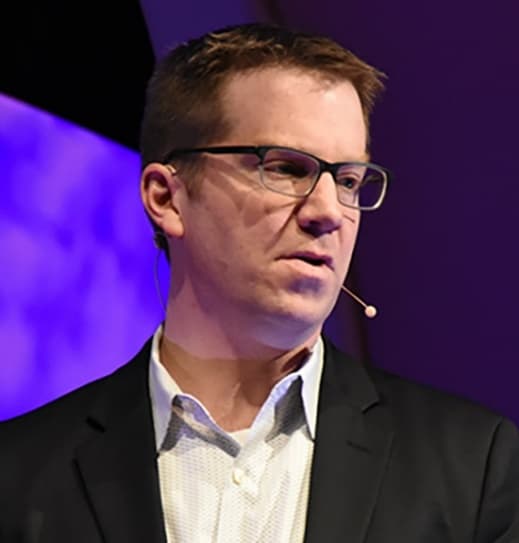
Timothy W. Simpson is the Paul Morrow Professor of Engineering Design & Manufacturing, Director of the Additive Manufacturing & Design Graduate Program, and Co-Director of the Center for Innovative Materials Processing through Direct Digital Deposition (CIMP-3D) at Penn State University (USA). He has published over 350 peer-reviewed journal and conference papers, and he is the lead editor on two books on product family design, Product Platform and Product Family Design: Methods & Applications, and Advances in Product Family and Product Platform Design: Methods & Applications. He has collaborated on product platform development projects with over 40 companies to date. The short course on product family and product platform design that he co-teaches at MIT has engaged more than 300 industry practitioners over the past 15 years. He is a Fellow in ASME and an Associate Fellow in AIAA. He received his Ph.D. and M.S. degrees in Mechanical Engineering from Georgia Tech and his B.S. degree in Mechanical Engineering from Cornell University
3. NOTABLE ARTICLES AND VIDEOS
3.1 INCOSE Releases 30th Anniversary Video
From the INCOSE YouTube page:
“It is with great excitement and pride that we premiere the official INCOSE 30th anniversary video as we prepare for our 30th International Symposium. In producing this video, we set out to tell the rich story of INCOSE and to emphasize the significance of the systems engineer in addressing the earth’s grand challenges. We challenge you to imagine systems engineering in 30 years’ time, and to continue the strong tradition of collaboratively engineering solutions that do, indeed, make the world a better place.”
https://www.youtube.com/watch?v=gDbp0OitfwI
3.2 Updates to INCOSE Working Groups’ Activities
by
Ralph Young, Editor, PPI SyEN
INCOSE has made several updates concerning INCOSE’s Working Groups (WG). Some Working Groups have been retired or re-named; examples of renamed Working Groups are the Critical Infrastructure, Protection, and Recovery WG, Knowledge Management & Ontologies WG, and the Systems Engineering in Early Stage Research and Development. New Working Groups include Artificial Intelligence Systems; Configuration Management; Digital Engineering Information Exchange; Integration, Verification, & Validation; MBSE Patterns; Value Proposition Initiative; and Value Strategic Initiative.
A new feature is that Working Group Information Sheets (WIS) were developed at the INCOSE International Workshop (IW) 2020 for all of the WGs. Each WIS contains some basic information about the Working Group as well as results of its activity at IW2020.
INCOSE’s Working Groups create resources that practitioners need. INCOSE members can discuss, collaborate, and share in-person and online across 53 Working Groups with a wide diversity of interests. INCOSE Working Groups create products, present panels, and develop and review standards.
By participating in INCOSE’s Working Groups, you will:
- Provide value to other INCOSE stakeholders in your interest area,
- Develop expertise and make contacts,
- Help develop and review international standards,
- Share information across Working Groups, and
- Create products to advance the state, art, and practice of systems engineering.
To execute its mission, INCOSE’s Technical Operations has a functional structure, as depicted in the illustration below:
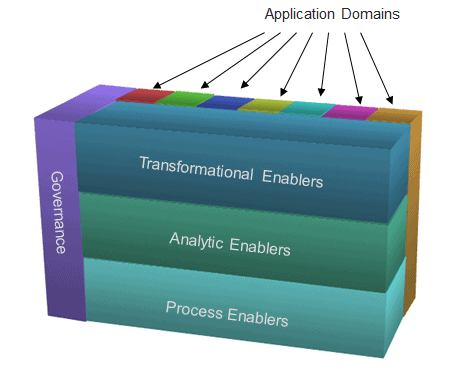
INCOSE’s Working Groups are organized into the areas of transformational enablers, analytic enablers, process enablers, and application domains.
Following is a list of the Working Groups as of May 2020, together with the name of the Chair(s) and the domain or enabler of each:
| Name | Chair | Domain/
Enabler |
| Agile Systems and Systems Engineering | Rick Dove / Ron Lyells / Larri Rosser | Transformational |
| Anti-terrorism International | Bill Mackey | Application Domains |
| Architecture | R. Martin / A Kumar / JL Garnier | Process Enablers |
| Artificial Intelligence Systems | Thomas Shortell / Tom McDermott | |
| Automotive | Alain Dauron / Gary Rushton | Application Domains |
| Competency | Cliff Whitcomb / Lori Zipes | Analytic Enablers |
| Complex Systems | Michael Watson / A. Raz / M. Do | Process Enablers |
| Configuration Management | Paul Nelson / Dale Brown /Adriana DSouza | |
| Critical Infrastructure, Protection, and Recovery | D. Eisenberg / J. Juhasz / A. Adebonojoa | Application Domains |
| Decision Analysis | Frank Salvatore / G. Parnell | Analytic Enablers |
| Defense Systems | Karl Geist | Application Domains |
| Digital Engineering Information Exchange | John Coleman / Frank Salvadore / Chris
Schreiber |
Transformational |
| Enterprise Systems | K. Nortrup / T. McDermott | Process Enablers |
| Global Earth Observation System of Systems (GEOSS) | Ken Crowder | Application Domains |
| Healthcare | Bob Malins / Chris Unger | Application Domains |
| Human Systems Integration | Guy Boy | Analytic Enablers |
| Infrastructure | Alain Kouassi / L. Uden / M. vande Ven | Application Domains |
| Integration, Verification, & Validation | Jim Armstrong / Russell Kubycheck | Process Enablers |
| Knowledge Management & Ontologies | Robert Nilsson / Jean Duprez | Transformational |
| Lean Systems Engineering | Arthur Hyde | Transformational |
| MBSE Initiative | Mark Sampson | Transformational |
| MBSE Patterns | Bill Schindel / Troy Peterson | Transformational |
| Measurement | Paul Frenz | Process Enablers |
| Model-based Conceptual Design | Randall Satterwaite / Robert Lecorchick | Transformational |
| Natural Systems | Curt McNamara / Randy Anney | Analytic Enablers |
| Object-Oriented SE Method | Howard Lykins | Transformational |
| Oil and Gas | Christopher Bellows / Alisha Pate | Application Domains |
| PM-SE (Emerging) | Jean-Claude Roussel / Tina Srivastava | Process Enablers |
| Power & Energy Systems | Ray Beach | Application Domains |
| Process Improvement | Jeffrey Brown / J. Clark | Transformational |
| Product Line Engineering | Hugo Chale / R. Darbin / C. Krueger | Analytic Enablers |
| Requirements | T. Katz / M. Ryan / R. Zinni / K. Orr | Process Enablers |
| Resilient Systems | John Brtis / Scott Jackson | Analytic Enablers |
| Risk Management | Jack Stein / Bob Parro | Process Enablers |
| SE in Early Stage R&D |
|
|
| SE Tools Database | J. Nallon / S. Lacrampe / R. King | Transformational |
| Small Business SE | Robinson / Ptack / Laporte / Kaffenberger | Transformational |
| Social Systems | Ericka Palmer / Randall Anway | |
| Soft Skills | Sean McCoy / J. Wojcika / C. Whitcomb | Transformational |
| Space Systems | David Kaslow / Alejandro Levi | Application Domains |
| System of Systems | Alan Harding / Judith Dahmann | Analytic Enablers |
| Systems Science | J. Calvo-Amodio / J. Martin / S. Natarajan | Transformational |
| Systems Security Engineering | Rick Dove / Keith Willet / Beth Wilson / Ken Kopchar | Analytic Enablers |
| Tools Integration & Model Lifecycle Management | John Nallon | Transformational |
| Training | Gabriela Coe / John Clark | Analytic Enablers |
| Transportation | Dale Brown | Application Domains |
| Value Proposition Initiative | Juan Amenabar / Ken Harmon | |
| Value Strategic Initiative | Juan Amenabar / Ken Harmon | Transformational |
3.3 INCOSE Brasil Chapter YouTube Channel
The INCOSE Brasil Chapter has a YouTube channel that covers topics ranging from questions and answers about the INCOSE Systems Engineering Handbook, responding to COVID-19 and features of the series on ‘Systems Talks’.
View videos or subscribe to the channel here:
https://www.youtube.com/c/INCOSEBrasil
3.4 YouTube Presentation by Professor Jose Fernandez – April 29, 2020
The ISE & PPOOA MBSE Methodology: A Practical Approach to Apply Model Based Systems Engineering
ISE = Integrated Systems Engineering
PPOOA = Pipelines of Processes in Object Oriented Architecture
Download the slides for this presentation here.
Sussman was a professor for over 50 years and served as department head in CEE from 1980 to 1985. In 1991 he was awarded the inaugural JR East Professorship, an endowed chair that spurred the establishment of a long-standing partnership between the East Japan Railway Company (JR East) and MIT. He was awarded the CEE Distinguished Service and Leadership Award in 2017 for his devotion to encouraging a culture of diversity, inclusiveness, and innovation and for embodying the department mission and vision of MIT.
More Information
4.2 SERC Research Review Scheduled for November 2020
The 12th Annual Systems Engineering Research Consortium’s (SERC) Sponsor Research Review is scheduled for November 17-18 in Washington D.C. USA. This two-day event unites the government, industry, and university systems engineering research community in order to share research progress and discuss the most challenging systems engineering issues facing the Department of Defense (DoD) as well as other federal departments and agencies. It includes the SERC doctoral students review forum on November 17th, and the SERC Sponsor Research Review on November 18th.
4.3 Call for Papers: “Engineering Ethics: Bridging the Theory – Practice Gap”
International Journal of Technoethics
Over the course of the last several decades, scholars and practitioners have been motivated to reflect on engineering because it can be important for society. While many engineers love to build things and have an innate sense of wanting to help society, in individual contexts it can be unclear what the ethical thing to do is and how an engineered system will affect society. The power that engineers have been implicitly granted and the overall complexity of social and engineering systems establishes the challenge of helping society. Philosophers and other scholars have provided practical and ethical advice for engineering, but such advice can be disconnected from how engineering systems are actually developed and managed. Ethical dialog on engineering benefits from a sense of how institutions work and what knowledge gets brought to bear in the design and operations process.
As a consequence, various approaches that center on stakeholders, human values, and the environment have been proposed as methodologies to adopt early on and throughout design practices. Although some of these approaches have been more successful than others, the literature concerning their continued sustainability and their resulting products has yet to be widely disseminated. This is particularly important in designing for value change across sociocultural boundaries.
Bringing engineers and philosophers into deeper conversation allows for both to learn from each other, and can serve as a community to reflect on society’s broader approach toward engineering and its governance. This special issue aims to gather high-level research to comprehensively index the current state-of-the-art research in the field of engineering ethics and design, and also, to address anticipated future trends.
Objective
The aim of this special issue is to provide a platform for the researchers, scholars, academicians, and practitioners from different areas of the world to discuss various methods, disciplines, and traditions across both philosophy and engineering in order to explore what current conceptual frameworks have shown the most potential, and how we can saliently move from theory to practice in a world of exponential technological advancement.
Scholarly papers are invited from all over the world for publication in this issue.
Recommended Topics
Topics to be discussed in this special issue include (but are not limited to) the following:
- Philosophy of engineering and technology
- Ethics related to engineering and technology
- Philosophy / ethics in engineering education
- Value sensitive design and responsible innovation
- Interdisciplinary reflections on engineering practice
- Philosophical theories of value change
- Ethics-aware requirements engineering
- Lessons learned with respect to ethical aspects in digital projects
- Design approaches and technology policy innovation
Submission Procedure
Researchers and practitioners are invited to submit their original empirical research articles 5,000 to 7,000 words in length. Interested authors must consult the journals’ guidelines for manuscript submissions at http://www.igi-global.com/publish/contributor-resources/before-you-write/ prior to submission. All submitted articles will be reviewed on a double-blind review basis by no fewer than 3 members of the journal’s Editorial Review Board and 1 Associate Editor. Final decision regarding acceptance/revision/rejection will be based on the reviews received from the reviewers and at the sole discretion of the special issue guest editor.
All manuscripts must be submitted through the eEditorial Discovery online submission manager: http://www.igi-global.com/submission/submit-manuscript
All submissions and inquiries should be directed to the attention of Steven Umbrello,
University of Turin, Italy; Institute for Ethics and Emerging Technologies
steven.umbrello@unito.it
https://www.igi-global.com/journal/international-journal-technoethics/1156
Submission Due Dates
Initial paper submission deadline: December 1, 2020
Initial round of review to be completed by: February 1, 2021
Revised paper submission deadline: March 1, 2021
Second round of review to be completed by: April 1, 2021
Submission of accepted papers for journal copyediting processes: May 1, 2021
Publication of special section papers: July 2021
Guest Editors
Steven Umbrello (University of Turin, Italy; Institute for Ethics and Emerging Technologies)
Baha Abu-Shaqra (University of Ottawa)
4.4 Job Vacancy: Professor/Associate Professor in Systems Engineering for Cyber-Physical Systems
About the position
NTNU’s Faculty of Information Technology and Electrical Engineering is establishing a new professorship in Systems Engineering for Cyber-Physical Systems, affiliated with the Department of Engineering Cybernetics.
Systems engineering is an interdisciplinary field focusing on design, integration and management of complex systems, from a holistic perspective over the life cycle. Systems-thinking principles and modelling methods are used to organize this process.
A systems-engineering approach ensures that all relevant aspects of a system are considered for an integrated solution.
Cyber-physical systems include physical and software components for sensing and control, that may be deeply interconnected, can operate on different spatial and temporal scales, exhibit multiple and distinct behavioral modalities, and interact with each other in context-dependent ways.
You will report to the Head of Department.
Duties of the position
The position is within the field of Systems Engineering for Cyber-Physical Systems. Relevant such applications at the department include sensing and control in underwater robots, autonomous marine vessels, unmanned aerial systems, small satellite systems, and other cyber-physical systems.
The professor is expected to play a leading role in research and research-based education for Systems Engineering for Cyber-Physical Systems at the department, in particular to contribute to the following aspects of such systems:
- Requirement analysis and specification
- Functional and architectural design
- Hardware and software architecture
- Systems implementation and integration
- Regulatory frameworks, certification, safety, reliability, maintenance, verification and validation
- Environmental factors (such as temperature, pressure, humidity, mechanics and vibrations, emissions, radiation, etc.), electromagnetic compatibility and energy management
- Packaging, documentation, quality and life-cycle management
The research activities at the department rely mainly on external funding, and the development of educational programs may also receive external funding. The professor is expected to engage extensively in applications for external funding, e.g. from the Research Council of Norway, European research and educational agencies, the industry sector, and other available sources.
MSc and PhD candidates from the cybernetics study programs are expected to be competitive in an international job market. The professor will contribute toward the department’s educational profile and promote an excellent learning environment, in collaboration with colleagues, students and external stakeholders. Specifically, the professor is expected to teach a minimum of one course at the department’s MSc program and a specialization course at MSc or PhD level, as well as supervising MSc students, PhD candidates and postdoctoral fellows.
In addition to research and education, the professor is expected to disseminate relevant parts of the research to a wider audience.
The professor is also expected to participate in the formal management of research, education, innovation and other relevant areas of activity at the department.
Visit the site for information regarding requirements, the offer and the application please click here.
4.5 June 2020 Edition of the Digital Engineering Working Group Available
To further the digital engineering effort, the DoD Engineering office leads the Digital Engineering Working Group (DEWG) whose participants represent segments of the engineering and acquisition communities including Program Executive Offices, Program Managers, engineering, and science and technology proponents. The DEWG promotes digital engineering principles throughout the Services and other agencies and can assist in advancing digital engineering practices
Download the June 2020 edition of the monthly newsletter here:
https://sercuarc.org/digital-engineering-working-group-june-2020-newsletter/
4.6 INCOSE Seeks Candidates for Deputy Technical Director
INCOSE is looking for candidates for the Deputy Technical Director position which will become vacant in January at IW2021. If you or someone you know is interested in applying for the position or would like to learn more please contact Dr. David Endler, the current Technical Director, or Chris Hoffman, the current Deputy Technical Director. If you are interested you can upload your profile at https://www.incose.org/about-incose/volunteer-opportunities/vo-request.
4.7 Submit Papers to the 4th Complex Systems Design & Management Asia Conference
From the CSD&M Asia Conference Website:
To deal with any complex problems, the Model-Based Systems Engineering and CESAMES Systems Architecting Method could help to find efficient modelizations & tools to solve quickly short-term problems and in parallel to project in long-term strategies. This 4th CSD&M Asia conference will be an opportunity to brainstorm on global systems in welcoming all actors from the academy, industries and governments interested in complex systems subjects such as MBSE, digital transformation or complex project management.
Accepted papers will be included into the 4th CSD&M Asia Conference Proceedings, published by Springer Verlag and referenced & indexed in DBLP, Ei Compendex, ISI Clarivate and Scopus.
Important dates
- Submission deadline: September 1, 2020
- Results announcement: October 1, 2020
- Final version: November 1, 2020
Access to submission procedure – click here
5.1 System of Systems Engineering Collaborators Information Exchange (SoSECIE)
The System of Systems Engineering Collaborators Information Exchange (SoSECIE) is a web-based seminar series organized by the USA Office of the Deputy Assistant Secretary of Defense (SE) in association with the USA National Defense Industrial Association’s SoS Engineering committee. The goal of this series is to provide guidance, education, and training for SoS and dissemination of engineering best practices within the government, military, contractors, academia, and International partners.
More Information
5.2 Centre for System Philosophy (CSP)
The Centre for Systems Philosophy (CSP) based in Surrey, UK is a not-for-profit organization funded by grants and private sponsors. The Founder and Managing Director of the Centre for Systems Philosophy is Dr David Rousseau. The Centre for Systems Philosophy was founded to support the development and promotion of Systems Philosophy as a component of General Systems Transdisciplinarity, and support the use of scientific philosophy and systems theory in addressing important problems in science, philosophy and society.
From the CSP website:
Systems Philosophy is the philosophical component of Systemology, the transdisciplinary field concerned with the scientific study of all kinds of systems. Systems Philosophy was formally founded in the 1970s as a scientific branch of philosophy, that is, one that respects and incorporates the findings of science, and proceeds in the way science does, i.e. by insisting on rigor, internal consistency, clarity, consistency between theory and observations, and subjecting its theories and models to empirical testing.
Read more about Systems Philosophy and the CSP here.
5.3 International Society for the System Sciences (ISSS)
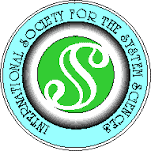
The International Society for the Systems Sciences is a worldwide organization for systems sciences. The overall purpose of the ISSS is: “to promote the development of conceptual frameworks based on general system theory, as well as their implementation in practice. “
Visit the ISSS website here.
5.4 New England (USA) Complex Systems Institute
The New England Complex Systems Institute (NECSI) is an independent academic research and educational institution with students, postdoctoral fellows and faculty. NECSI has co-faculty, students and affiliates from MIT, Harvard, Brandeis and other universities nationally and internationally.
NECSI research advances fundamental science and its applications to real world problems, including social policy matters. NECSI researchers study networks, agent-based modeling, multiscale analysis and complexity, chaos and predictability, evolution, ecology, biodiversity, altruism, systems biology, cellular response, health care, systems engineering, negotiation, military conflict, ethnic violence, and international development.
NECSI conducts classes, seminars and conferences to assist students, faculty and professionals in their understanding of complex systems. NECSI sponsors postdoctoral fellows, provides research resources online, and hosts the International Conference on Complex Systems. Through its education, NECSI strives to contribute to science and the betterment of society.
5.5 Institute for Ethics and Emerging Technologies
From the Institute of Ethics and Emerging Technologies:
The Institute for Ethics and Emerging Technologies (IEET) is a “techno progressive think tank” that seeks to contribute to understanding of the likely impact of emerging technologies on individuals and societies by “promoting and publicizing the work of thinkers who examine the social implications of scientific and technological advance”. It was incorporated in the United States in 2004, as a non-profit 501(c)(3) organization, by philosopher Nick Bostrom and bioethicist James Hughes.
Find out more
6. News on Software ToolS Supporting
Systems Engineering
6.1 Phoenix Integration Awarded a NASA SBIR Phase II to Develop a Collaborative Framework for Model Based Engineering Sharing
On June 16, 2020 Phoenix Integration announced their award of the SBIR Phase II for NASA to develop a trusted, collaborative framework for Model Based Engineering sharing.
From the Phoenix Integration website:
Model Based Engineering has been adopted across the full product lifecycle in many organizations. However, the ability to share disparate models across teams, organizational boundaries, and among communities of practice is a challenge. Model reuse is important because it minimizes the need to re-invent the wheel for each new project or initiative. Additionally, organizations face the challenge of model traceability and results repeatability.
Phoenix Integration proposes to address these challenges by developing an easy-to-use analysis model sharing platform, coupled with a reliable and repeatable way of deploying those analysis models. Moreover, enabling the execution of these analyses on cloud computing resources opens the possibility of easy accessibility, including automatic model verification. This can be used across all industries and engineering applications, including aerospace & defense, automotive, scientific research and heavy industries.
“This research will enable us to create an engineering digital thread that is truly repeatable and traceable. It has been sought after in the engineering community for a long time. We are proud to be able to develop new technologies that expand upon our existing core capabilities and continue to provide useful innovations that directly meets our customer’s needs,” said Dr Andy Ko, Director, Engineering Services.
About Phoenix Integration
Phoenix Integration’s ModelCenter® is the framework for Model Based Engineering. ModelCenter® is a vendor-neutral software platform for creating and automating multi-tool workflows, optimizing product designs, and enabling Model Based Systems Engineering (MBSE). It is used by leading organizations worldwide to reduce development costs, improve engineering efficiency, stimulate innovation, and design more competitive products. Successful applications can be found in multiple industries, including aerospace, automotive, defense, electronics, energy, heavy industry, and shipbuilding. For more information, visit www.phoenix-int.com.
6.2 Autodesk Announces Construction Cloud
by
To aid construction teams in reducing miscommunication, errors and rework, Autodesk has developed the Construction Cloud to connect all stages of the building lifecycle: design, plan, build and operate. Built with BIM 360’s common data environment (CDE), Autodesk Construction Cloud ensures the team is collaborating on an integrated record set. The Construction Cloud is conformant with ISO-19650: Organization and digitization of information about buildings and civil engineering works, including building information modelling (BIM) — Information management using building information modelling — Part 1: Concepts and principles.
6.3 Altran Launches Code Defect AI
Altran announced the release of a new tool available on GitHub that predicts the likelihood of bugs in source code created by developers early in the software development process. By applying machine learning (ML) to historical data, Code Defect AI identifies areas of the code that are potentially buggy and then suggests a set of tests to diagnose and fix the flaws, resulting in higher-quality software and faster development times.
7. Systems Engineering Publications
7.1 Thriving at the Edge of Chaos: Managing Projects as Complex Adaptive Systems
by
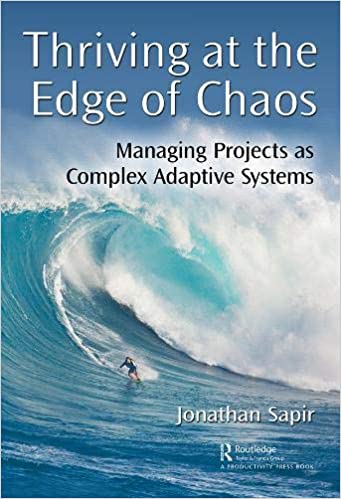
From the Amazon.com Website:
For many organizations, the way in which projects are managed is a fundamental factor in how well they can prosper in today’s marketplace. Unfortunately, the current solutions available to companies for managing projects are proving to be increasingly ineffective in a complex world that is becoming more and more dynamic and unpredictable.
Organization’s pay for this complexity in delayed time-to-market, slow response to customer needs, and decreased productivity. While tweaking the current project management paradigm may provide some minimal gains, to have a real impact requires a fundamental change in mindset.
New business models like Uber and AirBnB show us that the most efficient operations in today’s business environment behave like complex adaptive systems (CAS) where self-managing participants, following a set of simple rules, organize themselves to solve incredibly complex problems. Instead of trying to function like a “well-oiled machine” where things “work like clockwork”, companies like Uber function more like an organism that is alive and constantly changing. They fully embrace the characteristics of a CAS.
Viewing an organization as a complex adaptive system drives a radically new philosophy of project management that is much better suited to the needs of the 21st-century organization and can provide the quantum leap improvement in project production that we are looking for.
This book exposes the assumptions underlying the accepted paradigm of project management, describes the common practices that are based on those assumptions, analyzes why these practices are unhelpful and even harmful, and proposes an alternative, sometimes seemingly counter intuitive approach to project management based on CAS thinking.
By the end of the book, the reader will have a completely new perspective on the way projects can be managed in their organization, and how they can quickly start reaping the benefits provided by a CAS-driven management methodology and supporting toolset that is more in tune with today’s business demands – and that turns complexity into a competitive advantage.
Publisher: Productivity Press; 1 edition (December 2, 2019)
Format: Kindle, Hardcover, and Paperback
ISBN-10: 0367405407
ISBN-13: 978-0367405403
7.2 Risk Up Front: Managing Projects in a Complex World
by
Adam Josephs and Brad Rubenstein
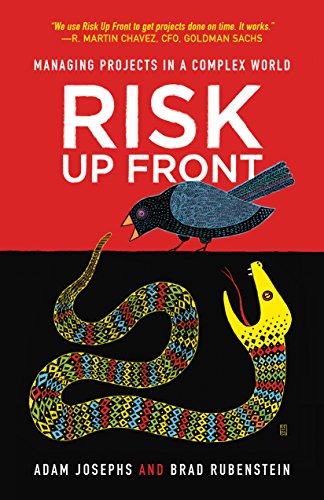
From the Amazon.com Website:
This book focuses on the fundamentals: simple structures and practices, applied with rigor. These are the tools you need to avoid the late changes that kill project schedules. Underlying all of them are four principles: accountability, transparency, integrity, and commitment. Risk Up Front is designed to turn these principles into practice.
Murphy’s Law tells us, “If anything can go wrong, it will.” With Risk Up Front, even risks hiding in your team’s blind spot can be discovered and handled, before Murphy has a chance.
Publisher: Lioncrest Publishing (June 4, 2018)
Format: Kindle, Audiobook, and Paperback
ISBN-10: 1544510861
ISBN-13: 978-1544510866
7.3 What is Disruptive Innovation?
by
Clayton M. Christensen, Michael E. Raynor, and Rory McDonald
From the December 2015 Issue of Harvard Business Review
This article is part of an effort to capture the state of the art. It begins by exploring the basic tenets of disruptive innovation and examining whether they apply to a specific company. Then it points out some common pitfalls in the theory’s application, how these arise, and why correctly using the theory matters. Then it traces major turning points in the evolution of thinking and make the case that what has been learned enables more accurate prediction of growth.
7.4 The Future of Systems Engineering
by
Michael D. Watson
From the May 2019 Issue of INCOSE INSIGHT
Abstract
Systems engineering has evolved as a practice-based discipline with a matured set of processes covering the life cycle of the system. The engineering basis is however tenuous, as we cannot always ensure the system will be successful. All engineering disciplines start in practice and, over time, evolve with the discovery of the underlying scientific principles that provide a solid foundation for the discipline. Systems engineering is following a similar course, with the recognition that it is also a sociological endeavor integrating, coordinating, and facilitating all the engineering disciplines. As a direct step from the systems engineering heuristics, a set of systems engineering principles emerged that incorporate the engineering basis and the sociological basis and are broader than system principles, that is, principles that define how a system functions. Systems scientists researched the mathematical basis of systems engineering for some time. Recent work has begun to show that mathematical category theory is the basis for defining systems. The future of systems engineering intertwines the scientific/mathematical engineering basis, system modeling advances, and advancements in technological and sociological practices to advance the ability of systems engineering to define systems, shorten design analysis cycles, validate systems, and effectively operate and maintain systems.
Read the Article (Requires Login to INCOSE Connect).
7.5 Systems Principles, Systems Science, and the Future of Systems Engineering
by
David Rousseau and Javier Calvo-Amodio
From the May 2019 Issue of INCOSE INSIGHT
Abstract
The rise of complexity in engineered systems is radically increasing the risks in complex systems engineering projects. This rise is a challenge for systems engineering, which is still based on heuristics and not yet grounded in a general theory of systems. Such a theory is needed if systems engineering is to improve its methods, processes, and tools systematically. This article reviews ongoing initiatives to develop this foundation.
Read the Article (Requires Login to INCOSE Connect)
7.6 Systems Engineering Principles and Hypotheses
by
Michael D. Watson
From the May 2019 Issue of INCOSE INSIGHT
ABSTRACT
The INCOSE Systems Engineering Principles Action Team has put forth a set of principles and hypotheses to articulate the basic concepts that guide systems engineering. The team based this work on a review of various sources of systems postulates, principles, and hypotheses identified in literature. They focused on the multi-year work of the NASA Systems Engineering Research Consortium looking at the work of Ludwig Boltzmann and his postulates on gas distributions as an early example of how to characterize the interactions of complex systems. The INCOSE Systems Engineering Principles Action Team review has distilled the earlier works to the 15 principles and three hypotheses stated in this article. The principles define the domain of systems engineering as well as the system aspects and system influences that are of concern to the systems engineer. The hypotheses contain some of the seeds of a holistic mathematical basis for systems engineering.
Read the Article (Requires Login to INCOSE Connect)
7.7 Practical Model-Based Systems Engineering
by
Jose L. Fernandez and Carlos Hernandez
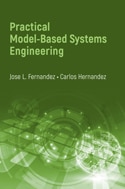
From the Artech House Website:
This comprehensive resource provides systems engineers and practitioners with the analytic, design and modeling tools of the Model-Based Systems Engineering (MBSE) methodology of Integrated Systems Engineering (ISE) and Pipelines of Processes in Object Oriented Architectures (PPOOA) methodology. This methodology integrates model based systems and software engineering approaches for the development of complex products, including aerospace, robotics and energy domains applications.
Readers learn how to synthesize physical architectures using design heuristics and trade-off analysis. The book provides information about how to identify, classify and specify the system requirements of a new product or service. Using Systems Modeling Language (SysML) constructs, readers will be able to apply ISE & PPOOA methodology in the engineering activities of their own systems.
Format: Hardcover
Publisher: Artech House (July 31, 2019)
ISBN: 9781630815790
8.1 Technical University of Madrid, Spain
The Technical University of Madrid was founded in 1971, from the merging of different technical schools, although its origins date as far back as the 18th century and the reign of King Carlos the Third.
Originally established to teach architecture and engineering in the country, the institution has grown rapidly and is now home to over 41,000 students. It comprises 21 separate schools based on four campuses across Madrid, with its Moncloa Campus denoted as an ‘International Campus of Excellence’, a distinction that acknowledges the quality of its research and teaching activity.
While the university’s courses have grown and adapted over the years to align with changes in industry, the institution has retained a technical focus and has several strategic partnerships with professional bodies and external research centers.
8.2 Rensselaer Polytechnic Institute (USA)
Founded in 1824, Rensselaer Polytechnic Institute is America’s first technological research university. Rensselaer encompasses five schools, 32 research centers, more than 145 academic programs, and a dynamic community made up of more than 7,900 students and more than 100,000 living alumni. Rensselaer faculty and alumni include more than 145 National Academy members, six members of the National Inventors Hall of Fame, six National Medal of Technology winners, five National Medal of Science winners, and a Nobel Prize winner in Physics. With nearly 200 years of experience advancing scientific and technological knowledge, Rensselaer is focused on addressing global challenges with a spirit of ingenuity and collaboration.
9. Some Systems Engineering-Relevant Websites
What is Machine Learning and How Does it Work?
Machine learning is a data analytics technique that teaches computers to do what comes naturally to humans and animals: learn from experience. Machine learning algorithms use computational methods to “learn” information directly from data without relying on a predetermined equation as a model. The algorithms adaptively improve their performance as the number of samples available for learning increases. Visit the MathWorks Machine Learning Website for more information.
What is Deep Learning and How Does it Work?
Deep learning is a machine learning technique that teaches computers to do what comes naturally to humans: learn by example. Deep learning is a key technology behind driverless cars, enabling them to recognize a stop sign, or to distinguish a pedestrian from a lamppost. It is the key to voice control in consumer devices like phones, tablets, TVs, and hands-free speakers. Deep learning is getting lots of attention lately and for good reason. It’s achieving results that were not possible before. Visit the MathWorks Deep Learning Website for more information.
10.1 Development of New Standards for Systems of Systems Engineering
In February 2019, Dr. Mike Yokell, Lockheed Martin Fellow and Deputy Director, Systems Engineering, provided a presentation concerning the following standards:
- ISO/IEC/IEEE 21839 –System of Systems (SoS) Considerations in Life Cycle Stages of a System
- ISO/IEC/IEEE 21840 –Guidelines for the utilization of ISO/IEC/IEEE 15288 in the context of System of Systems (SoS) Engineering
- ISO/IEC/IEEE 21841 –Taxonomy of Systems of Systems
Nearly all systems interact as part of a system of systems. Systems of systems engineering (SoSE) practice is maturing to the point that the International Organization for Standardization (ISO) has initiated the development of a set of SoSE Standards. This presentation outlines the background on the new SoS standards and describes the new standards in development. The structure and content of the standards are described along with the plans for continued development.
Dr. Mike Yokell is a Lockheed Martin Fellow and Deputy Director, Systems Engineering. He is the US representative to International Standards setting bodies for Systems and Software Engineering and is the project editor for two new international standards on Systems of Systems Engineering. Mike is certified as an expert systems engineering professional (ESEP) by the International Council on Systems Engineering (INCOSE). He holds multiple US and European Patents for Model Based Systems Engineering (MBSE) and large scale immersive virtual reality.
10.2 IEEE 2413TM-2019, Standard for an Architectural Framework for the Internet of Things (IoT)
This standard defines an architecture framework description for the Internet of Things (IoT).
The architecture ontology and methodology of the framework architecture conforms to the international standard ISO/IEC/IEEE 42010:2011. The architecture framework description is motivated by concerns commonly shared by IoT system stakeholders across multiple domains (transportation, healthcare, Smart Grid, etc.).
More information: https://standards.ieee.org/standard/2413-2019.html
11. Some definitions to close on
11.1 Resilience
Resilience is the ability to provide required capability in the face of adversity. The means of achieving resilience include avoiding, withstanding, recovering from, and evolving and adapting to adversity.
Classically resilience would include “withstanding” and “recovering.” There is accepted thinking that, for the purpose of engineered systems, “avoiding” adversity is a legitimate aspect of achieving resilience. Likewise, it is believed that resilience should encompass the system’s ability to “evolve and adapt” to future threats and unknown-unknowns.
Source: INCOSE Resilient Systems Working Group Webpage
11.2 Pipelines of Processes in Object Oriented Architecture (PPOOA)
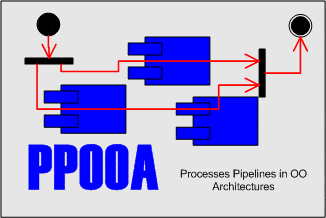
PPOOA is the result of 17 years of research led by Professor Jose L. Fernandez from Madrid Technical University (UPM), located in Madrid, Spain (http://www.etsii.upm.es/ingor/proyectos/). The main goal of PPOOA research is to offer a rigorous solution for architecting real-time systems that can be easily adopted by industry. It began with a taxonomy of coordination mechanisms for real-time systems developed by the author at the Software Engineering Institute (SEI): “A Taxonomy of Coordination Mechanisms Used in Real-Time Software Based on Domain Analysis”. CMU/SEI-93-TR-34. Software Engineering Institute, Carnegie Mellon University, December 1993.
Source: OMG WIKI on ISE and PPOOA
11.3 Complex Systems
1. Complex Systems is a field of science that explores how parts of a system give rise to its collective behaviors, and how the system interacts with its environment. Social systems, the brain, and weather are all examples of complex systems.
Source: New England (USA) Complex Systems Institute
2. A complex system can be described as one in which many different components interact in multiple ways. In the context of a design that is difficult to understand or implement, complexity is the quality of being intricate and compounded.
Source: D. Rind, “Complexity and Climate” in Science Magazine, 1999, pp. 105-107.
3. When project managers characterize a project as complex, they usually mean that the project is challenging to manage because of its size, complicated interactions, and/or uncertainties. Often, anxiety goes hand in hand with complexity.
Source: B. Michael Aucoin, Right-Brain Project Management: A Complementary Approach. Vienna Virginia: Management Concepts, 2007, p. 132.
11.4 Complex Adaptive Systems (CAS)
A complex adaptive system is a system in which a perfect understanding of the individual parts does not automatically convey a perfect understanding of the whole system’s behavior. In complex adaptive systems, the whole is more complex than its parts, and more complicated and meaningful than the aggregate of its parts. The study of complex adaptive systems, a subset of nonlinear dynamical systems, is highly interdisciplinary and blends insights from the natural and social sciences to develop system-level models and insights that allow for heterogeneous agents, phase transition, and emergent behavior.
Source: Wikipedia
11.5 Complexity Science
Complexity science helps us understand indirect effects and unintended consequences. Pushing “here” often has effects “there” because of interdependence. We see this in social problems and ecological disasters caused by our own actions.
Source: New England (USA) Complex Systems Institute
For more information on systems engineering related conferences and meetings, please go to our website.
The featured event for this edition is:
International Conference on Human Interaction & Emerging Technologies
August 27th – 29th, 2020
The IHIET 2020 Conference aims to provide a global forum for presenting and discussing novel human-interaction and engineering approaches, tools, methodologies, techniques, and solutions for integrating people, concepts, trends and applications in all areas of human interaction endeavor in industry, economy, government, and education, including but not limited to energy, transportation, urbanization and infrastructure development, digital manufacturing, social development, human health, sustainability, new generation of service systems, as well as safety, risk assessment, healthcare, and cybersecurity in both civilian and military contexts.
IHIET 2020 Conference will focus on advancing the theory and applications for human-interaction requirements as part of an overall system and product solution, by adopting a human-centered design approach that utilizes and expands on the current knowledge of user-centered design and systems engineering supported by cognitive software and engineering, data analytics, simulation and modeling, and next generation visualizations. This interdisciplinary conference will also expand the boundaries of the current state-of-the-art by investigating the pervasive complexity that underlies the most profound problems facing contemporary society today.
Emerging technologies include a variety of technologies such as educational technology, information technology, nanotechnology, biotechnology, cognitive science, psychotechnology, robotics, and artificial intelligence.
Abstract submissions have been extended to 31 July
Register or submit a paper for the conference here:
13.1 Robert Halligan Presents at INCOSE IS: ‘Developing the PPI-INCOSE SETDB Using an SE Approach’
On Wednesday 22 July at 17:50-18:30 UTC+2, PPI’s Managing Director Robert Halligan will be presenting at INCOSE’s Virtual Symposium about the systems engineering approach used to develop PPI-INCOSE Systems Engineering Tools Database. The SETDB is a joint project between PPI and INCOSE that begun in 2018 and is set to deliver its first initial operational capability in Q4 of 2020. Robert will be presenting alongside John Nallon, the chair of the SETDB Working Group and fellow project board member.
13.2 PPI Exhibits at the INCOSE IS, 20-22 July 2020
2020 has brought with it a number of plot twists notably the COVID-19 pandemic. Typically, at this time of the year, PPI sends a few of its staff to a location somewhere around the world to set up shop, shake hands with new and old friends and join a room of engineers eager to learn and exchange ideas for INCOSE’s annual International Symposium. This year is just a little different. From 20-22 July, we will be logging into the PPI’s Virtual INCOSE IS Platform and shaking virtual hands with friends, old and new, in the name practice systems engineering. We are looking forward to this experience and are delighted with INCOSE’s commitment to bring people together in the name of systems engineering despite the challenges experienced along. If you will be joining us, please do come and say hi in our virtual room. We would love to say hello and find out how you and your company are responding to the challenges of 2020. There is definitely something we can all learn from each other to come out stronger on the other side of these challenges. We also hope that the INCOSE IS will indeed take place in Cape Town, South Africa sometime in the future as originally planned!
13.3 At last: Interface Engineering and Management Training for the World
We are delighted to announce the addition of two days total duration of Interface Engineering and Management training to our portfolio of training courses in support of project and engineering excellence. The training will be delivered over 2 days, 4 half-days and 14 1-hour modules. And even better news is that the training will be delivered by Mr. Paul Davies, already well known for his many accomplishments in engineering and management, some of which are described below.
Paul held senior positions with Network Rail and Thales UK. Paul has been a Visiting Professor at Loughborough University and a Visiting Fellow at Bristol University, and also a member of the conseil d’administration of the prestigious Institut Supérieur de l’Aeronautiqe et de l’Espace in Toulouse. He has acted as industrial supervisor for a number of PhD, Engineering Doctorate and Masters students at five universities in the United Kingdom.
He is a Past President of the INCOSE UK Chapter, in which role he founded its sponsoring Advisory Board and compiled its first entry into the INCOSE Chapters Awards, immediately winning a Gold Circle Award at the first attempt, and subsequently the President’s Award for Outstanding Chapter. At international level, he has undertaken leadership roles on the Requirements Working Group and the SE Management Technical Committee, and as Outreach Director. He also acted as Master of Ceremonies at three INCOSE International Symposia. Paul’s efforts for INCOSE were recognised by his being given the Founders’ Award in 2015.
Paul has conducted training courses and workshops in requirements, interface management, verification and validation, systems engineering management, competency assessment, and SE return on investment, with very positive feedback. He has been in constant demand for the presentation of courses and tutorials at many INCOSE events, both in the UK and internationally, winning several Best Paper and Presentation Awards. He has presented and coached in French and Spanish as well as English.
With such a good alignment of aims, SE outlook, and commitment to excellence, Paul was delighted to join the Project Performance International/Certification Training International team in July 2017, as a Principal Consultant and Presenter.
The first public delivery by Paul of PPI’s new Interface Engineering and Management course will be over November 2-5, 2020, delivered as four half-day modules. Delivery timing matches European afternoons, which makes for practical participation of engineers and managers from San Francisco in the USA to Ankara in Turkey, and everywhere between.
Read more and register here now.
13.4 PPI Turns 41
Not years, but countries! Brunei last month became the 41st country in which PPI has delivered systems engineering training, with PPI Live-Online™ delivery of our flagship 5-day systems engineering course to an enthusiastic group of engineers and managers, pictured below (picture used with permission)
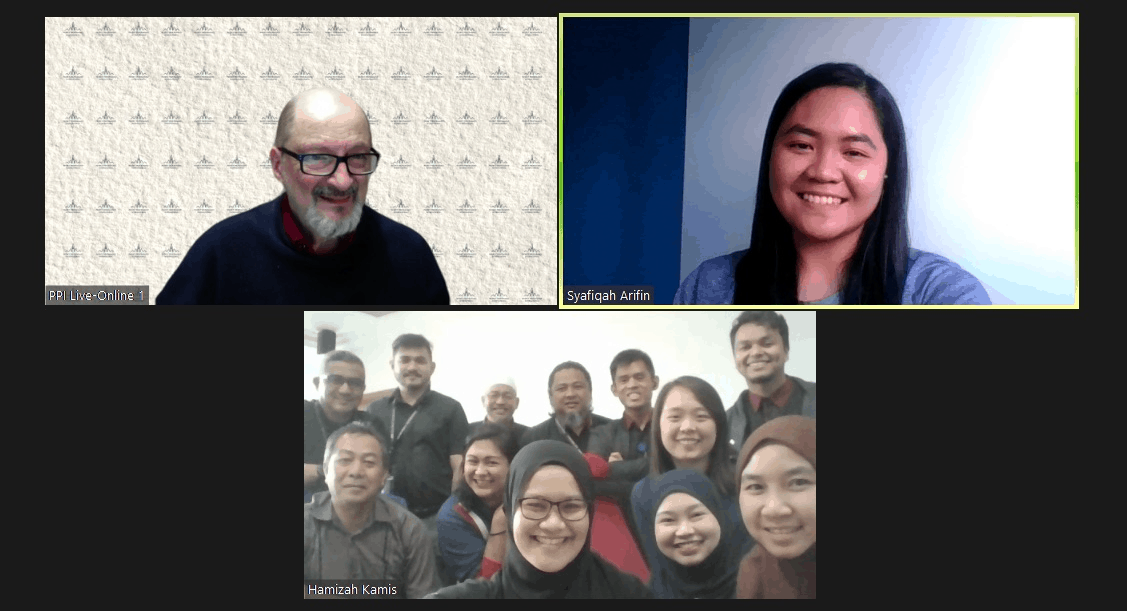
For a full public PPI Live-Online™ training course schedule, please visit https://www.ppi-int.com/ppi-live-online/
For a full public PPI training course schedule, please visit https://www.ppi-int.com/course-schedule/
For a full public CTI Live-Online™ INCOSE SEP Exam Preparation course schedule, please visit https://certificationtraining-int.com/incose-sep-exam-prep-course/
To enquire about CTI Live-Online™ INCOSE SEP Exam Preparation Training for your organization, please visit https://certificationtraining-int.com/on-site-training/
15. Upcoming PPI Participation in Professional Conferences
PPI will be participating physically in the following upcoming events. We support the events that we are sponsoring, and look forward to meeting old friends and making new friends at the events at which we will be exhibiting.
The INCOSE International Workshop 2021
Date: 29 – 31 January, 2021
Location: Seville, Spain
Kind regards from the PPI SyEN team:
Robert Halligan, Editor-in-Chief, email: rhalligan@ppi-int.com
Ralph Young, Editor, email: ryoung@ppi-int.com
René King, Managing Editor, email: rking@ppi-int.com
Project Performance International
2 Parkgate Drive, Ringwood, Vic 3134 Australia
Tel: +61 3 9876 7345
Fax: +61 3 9876 2664
Tel Brasil: +55 12 9 9780 3490
Tel UK: +44 20 3608 6754
Tel USA: +1 888 772 5174
Tel China: +86 188 5117 2867
Web: www.ppi-int.com
Email: contact@ppi-int.com
Copyright 2012-2020 Project Performance (Australia) Pty Ltd, trading as
Project Performance International
Tell us what you think of PPI SyEN. Email us at syen@ppi-int.info.



